Martin Burgess, 1842 – 1891
by Brian Stevenson
last updated December, 2014
Slides in many
collections bear the monogram “MB” (Figure 1). Brian Bracegirdle’s Microscopical Mounts and Mounters plate 5-S shows a slide similar to that in Fig. 1A, and on page 66 describes the
monogram as having “unknown significance”. A similar slide, with green papers, is shown in Figure 1B. Other versions of this mounter’s papers
indicates that “MB” was Martin Burgess (Figure 1C and D). While Dr. Bracegirdle’s book did not link MB with Burgess,
it does mention on page 19 that Burgess was known to have made “an assortment of papered slides,
in the 1880s”. Also illustrated in Figure 1 are two other slides bearing an oval with the monogram
“MB” and handwriting similar to the other illustrated slides (Figure 1 E and
F). Those last two slides may be
early mounts by Burgess, before he began using customized papers, or may be
later mounts/acquisitions from his personal collection after he ceased his
slide-selling business. Following
is a biography of Martin Burgess that I have gleaned from historical records.
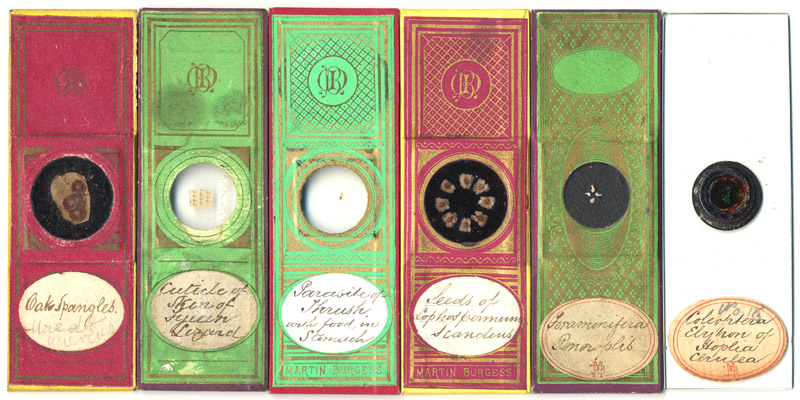
Figure 1.
Six microscope slides associated with Martin Burgess. The first four were prepared by Burgess, while the last two may have been acquisitions labeled by him.
(A) Gold ink on red paper, with monogram “MB”, Oak Spangles.
(B) Same as A, on green paper, with monogram “MB”, Cuticle of Skin of Fijian Lizard. Burgess advertised this preparation for sale in December, 1871.
(C) Gold ink on green paper, more ornate,
with monogram “MB” at the top and the maker’s name at the bottom, Parasite of
Thrush with food in Stomach.
(D) Same as C, on red paper, Seeds of Lophospermium scandius. Burgess advertised this preparation for sale during mid 1872.
(E) Side covered with generic green paper, and bearing an oval label with an “MB”
monogram, Foraminifera Peneroplis. (F) An unwrapped slide with
the same type of monogrammed oval label as E, Coleoptera Elytron of Hoplia
cerulea.
Martin Burgess was born in Peckham, Surrey, toward the end of 1842. He was the eldest of five children of Martin and Priscilla Burgess. The father was a master printer, employing two men at his works in Newington, Surrey, in 1861. According to the 1861 census, Martin junior then worked as a clerk in a building society.
Martin Burgess next appears in historical records on August 26, 1870, when he was elected a member of the Quekett Microscopical Club. During the following year, he is reported in the Journal of the QMC as having displayed specimens of “transverse section of beech” and Campylodiscus costatus, suggesting a diversity of microscopical interests.
By 1871, Martin Burgess had begun a business of producing and selling microscope slides. His advertisements were regularly featured in Nature and Hardwicke’s Science-Gossip, giving his address as 3 Mount Pleasant Terrace, Upper Lewisham Road, SE (New Cross, greater London) (Figure 2). A variety of exotic items were offered, including “Cuticle of Skin of Fijian Lizard”, “Beautiful winged Seed from Ceylon (mounted), Lophospermum Scandius”, “Section of Funcus communalis (Rush) showing the Stellate Cells”, “Diatomaceae, Yarra Yarra, Australia” and “Selected Foraminifera – Orbitolites and Quinqueloculina Bronniana”. Martin’s business sense appears to have developed as time passed: initially, he advertised as “M.B.”, but
by December, 1871, his ads contained his full name. Burgess also learned about effectively reaching potential customers: in 1871 and early 1872 he offered to sell his List of Objects for 2 stamps, but by April, 1872, he distributed the list “Gratis on application”, apparently realizing that people were unlikely to pay him simply for a catalog of his offerings.
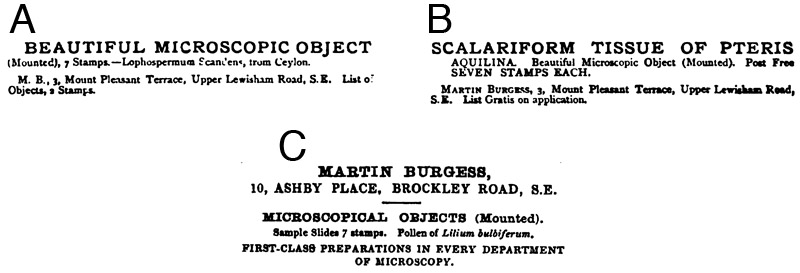
Figure 2. Advertisements from Martin
Burgess, appearing in Nature, vol. 4, November 2, 1871 (panel A) and Nature,
vol. 5, April 25, 1872 (panel B), and Hardwicke’s Science Gossip, 1873 (panel C).
Martin Burgess continued to advertise through at least 1873. The October, 1873 issue of Hardwicke’s Science-Gossip carried an exchange offer from Burgess, “Good Birds Eggs or Lepidoptera wanted for well mounted Microscopic Slide or Material”, suggesting that by this time in life he was as interested in collecting natural history objects as he was in making money from selling slides.
Burgess remained a member of the Quekett Microscopical Club through at least 1875. On 14 March, 1879, he exhibited “Anther and Pollen of Lavatera rubra”, but was no longer listed as a club member. Burgess was also active in several other natural history societies, displaying “a foot of lady-bird” at the annual soiree of the Croydon Microscopical Club “on Wednesday evening, November 8th, 1871, in the Public Hall”. In 1873, Martin Burgess was instrumental in the formation of The New Cross Microscopical and Natural History Society, serving that year as the club’s secretary (Figure 3). During 1880, Burgess served as the New Cross society’s president. An 1880 issue of Hardwicke’s Science-Gossip described the magazine as
having “received the seventh annual
report of this society. It contains an abstract of their monthly meetings,
which appear to have been very productive, and Mr. Martin Burgess's (President)
address, printed in full.” Insight to such clubs and Victorian life are found in the following
extract from The Transactions of the Essex Field Club: “Saturday, June 19th,
1880 – A Field Meeting of the Club was held in conjunction with the New Cross
Microscopical and Natural History Society, the members of the two societies
meeting at Theydon Bois on the arrival of the 2:13 train from London. The meeting was conducted by the
respective Presidents and Secretaries of the Societies, Messrs. Martin Burgess,
R. Meldola, Frederick Stewart, and W. Cole…Mr. Martin Burgess, President of the New Cross Society, returned thanks for the cordial welcome accorded members of his Society. They had that
afternoon seen some of the beauties of Essex, and he hoped it would not be the
last occasion on which the two Societies might be able to co-operate in so
pleasant and profitable a way.”
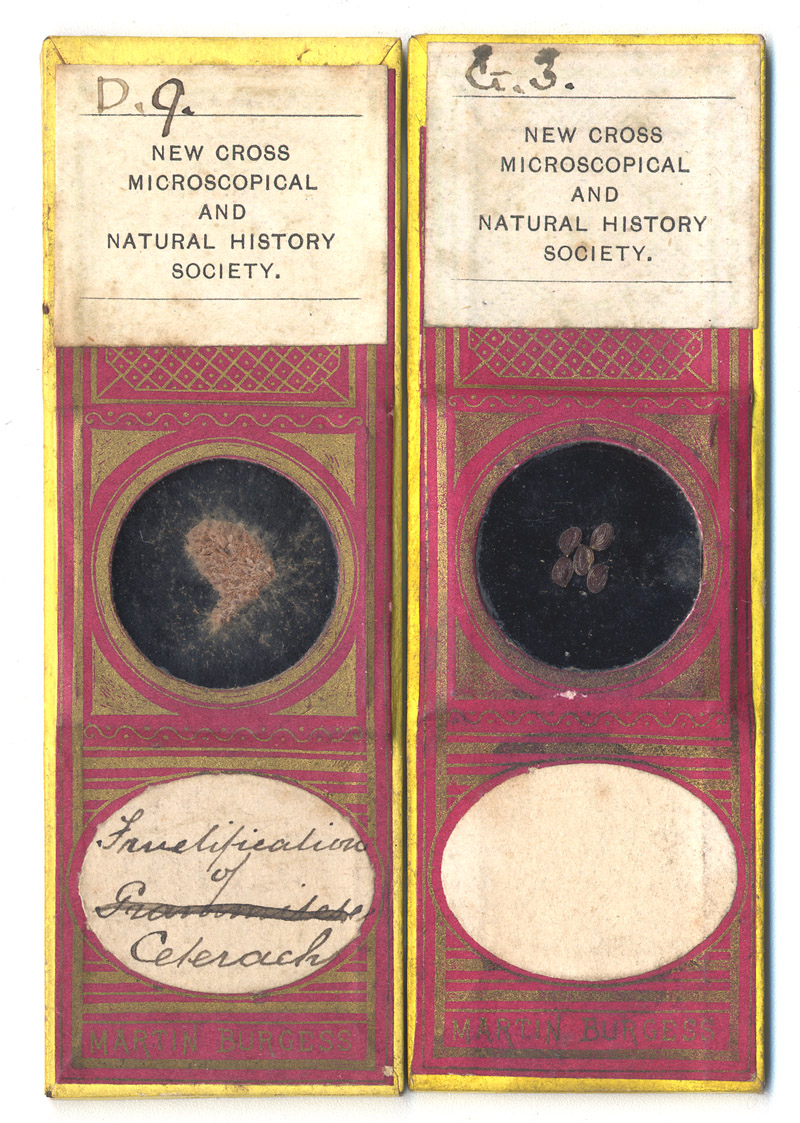
Figure 3. Two microscope slides by Martin Burgess, apparently donated by him to The New Cross Microscopical and Natural History Society.
Martin Burgess married Mary Ann Swan during 1865, and had three children over the following
years, first a daughter, Jessie, then two sons, William Henry and Frances
Sydney. The 1871 England census
lists Martin’s occupation at the time to be “Accountant/Collector”. By 1873, the family had moved to 10
Ashby Place, Brockley Road, S.E., in 1881 they lived at 64 Breakspears Rd.,
Deptford St. Paul, and in 1891 lived at 8 Colfe Rd., Sydenham, Lewisham,
London. The family was relatively well-off, the 1871 and 1881 censuses listing
them as having employed a teenage girl as their live-in domestic servant. The 1881 census and subsequent records
list Martin’s occupation as “Printer”, perhaps continuing his father’s
business. That trade may account
for the elegant, personalized slide wrappers used by Martin Burgess.
Probably due
to illness, Martin Burgess retired from business by 1891. Income for the household was provided
by his 18 year-old son William, a “cycle engineer’, and his brother-in-law,
Edward Swan, who ran a book and music shop. Martin Burgess died 1 Nov., 1891, at the age of 47, from
uremia resulting from a “traumatic stricture” incurred 8 years previously (a
crushed urethra, which makes urination difficult and apparently led to build up
of lethal amounts of toxins in Martin’s body).
This information suggests that most microscope slides from
Martin Burgess / “MB” date from the early 1870s, when his microscopy business was active. It is also probable
that some slides are from later dates, from either his personal collection,
gifts to friends, or exchanges with other naturalists.
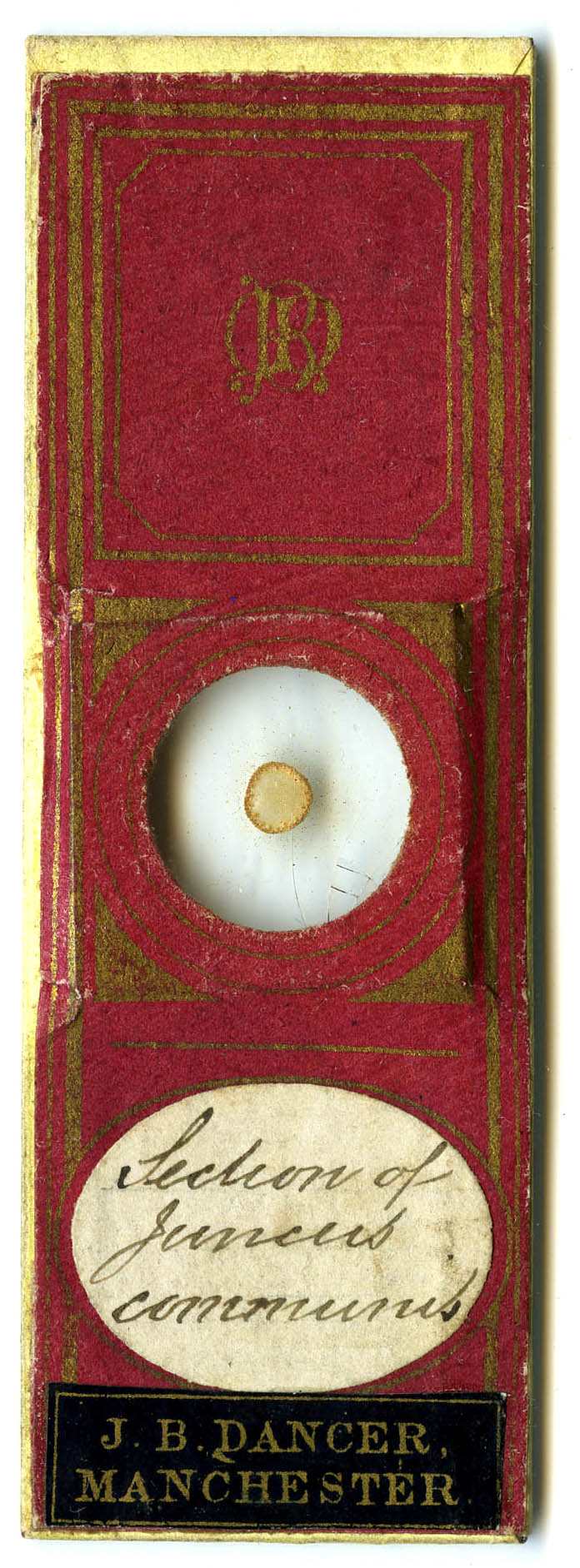
Figure 4. A slide by Martin Burgess, resold by John B. Dancer.
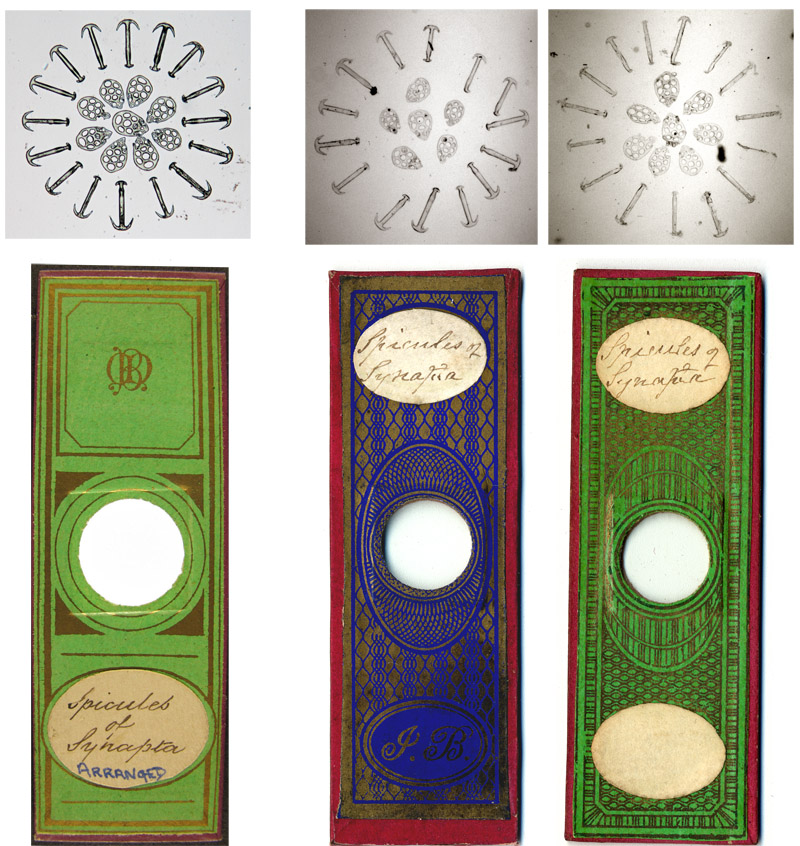
Figure 5. A Burgess-labeled slide that was probably made by professional mounter John Barnett. The pattern of arranged Synapta spicules on the Burgess slide is very similar to those on the two Barnett slides shown to the right (one with Barnett’s “JB’ monogram). I am not aware of such a skillful specimen arrangement on any other Burgess slide. As did/do many other microscopists, Burgess evidently relabeled slides he acquired from other makers.
Resources
Bracegirdle, Brian (1998) Microscopical
Mounts and Mounters, Quekett Microscopical Club, London, pages 19, 66 and 114, and plate 5-S
English vital statistics, accessed through www.ancestry.co.uk
Hardwicke's Science-gossip (1872) Vol. 8, pages xxxiii, lvii, etc
Hardwicke’s Science-Gossip (1880) Vol. 16, page 86
The Journal of the Quekett Microscopical Club (1870) Vol. 2, p 123
The Monthly Microscopical Journal: Transactions of the Royal Microscopical Society (1872) pages 284-287
Nature (1871-1872) Vol. 5, advertisements in numerous issues
Nature (1872) Vol. 6, advertisements in numerous issues
Nature (1873) Vol. 7, Jan 23, page 231
Transactions of the Essex Field Club (1881) Vol. 1, page xix.




